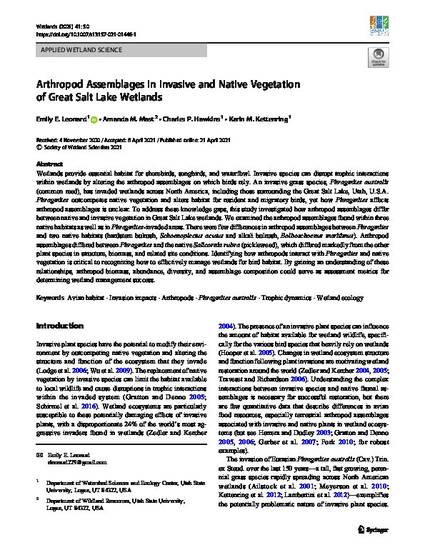
Article
Arthropod Assemblages in Invasive and Native Vegetation of Great Salt Lake Wetlands
Wetlands
(2021)
Abstract
Wetlands provide essential habitat for shorebirds, songbirds, and waterfowl. Invasive species can disrupt trophic interactions within wetlands by altering the arthropod assemblages on which birds rely. An invasive grass species, Phragmites australis (common reed), has invaded wetlands across North America, including those surrounding the Great Salt Lake, Utah, U.S.A. Phragmites outcompetes native vegetation and alters habitat for resident and migratory birds, yet how Phragmites affects arthropod assemblages is unclear. To address these knowledge gaps, this study investigated how arthropod assemblages differ between native and invasive vegetation in Great Salt Lake wetlands. We examined the arthropod assemblages found within three native habitats as well as in Phragmites-invaded areas. There were few differences in arthropod assemblages between Phragmites and two native habitats (hardstem bulrush, Schoenoplectus acutus and alkali bulrush, Bolboschoenus maritimus). Arthropod assemblages differed between Phragmites and the native Salicornia rubra (pickleweed), which differed markedly from the other plant species in structure, biomass, and related site conditions. Identifying how arthropods interact with Phragmites and native vegetation is critical to recognizing how to effectively manage wetlands for bird habitat. By gaining an understanding of these relationships, arthropod biomass, abundance, diversity, and assemblage composition could serve as assessment metrics for determining wetland management success.
Disciplines
Publication Date
2021
DOI
https://doi.org/10.1007/s13157-021-01446-1
Citation Information
Charles P Hawkins. "Arthropod Assemblages in Invasive and Native Vegetation of Great Salt Lake Wetlands" Wetlands Vol. 41 (2021) p. 50 Available at: http://works.bepress.com/charles_hawkins/257/
